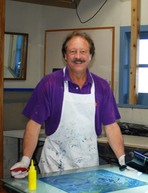
When I hear, compose or play music, I see, feel and sculpt the harmonic patterns. Many artists experience some form of synesthesia, wherein they see images of musical patterns and relationships. And many musicians see artistic imagery in their work. Artists can hear the paintings and sculptures; musicians view melodies, imagine etudes, and feel musical phrases.
The shared worlds of musical composition and artistic composition are well known and take many forms. The two fields share a similar lexicon, including words like line, movement, theme, rhythm, figure, form, space, harmony and counterpoint (contrasting element)... to name a few.
Composition takes on new meanings - both as a a noun (the finished work) and as a verb (the creative process). This process can be shared, and I have been making experimental paintings along these lines for many years, joining forces with a wide variety of artists and musicians from around the world. I have discovered that my improvisational approach to monotype oil painting, the so-called Chamberlain Method, is ideally suited for bringing out the personalities and characters of the players, for who we are comes out in the work (and, as with any small ensemble, there is no place to hide).
Called Duett Painting (with two t's), these collaborative artworks are made with simultaneous input from myself and a partner: both of us painting the same composition together at the same time. As with creating offspring, each duett painting embodies the aesthetic sensibilities of both partners, leading to in new and sometimes surprising combinations… captured in oil paint as a permanent visual record of the twosome.
Historically there have been many artful collaborations, although most have been serial in nature: I paint the background and then you paint the foreground; I do the figures and you do the faces; I make the sketch and send it to you to you complete the painting… I do the painting and you make the edition of prints.
The performing arts have enjoyed many examples of musicians, poets and dancers working together both serially and also simultaneously. Think about Joni Mitchell & Charles Mingus (pop/jazz); Bobby McFerrin & Yo Yo Ma (pop/classical); John Cage & Merce Cunningham, George Balanchine & Igor Stravinsky, and Twyla Tharpe & Elvis Costello (music/dance); Philip Glass & Joann Akalitis and Julie Taymore & Elliot Gldenthal (music/stage).
I wanted to explore how visual artists can work together simultaneously, like what is done in the performing arts with two modern dancers creating an improvisational pas-de deux in real time, or with two jazz musicians playing off each other trading eights and each influencing the thinking of the other along the way. There is no pre-conceived finished product; rather a broadly malleable agenda that can accommodate sudden inspirations and generate new areas of discovery and understanding.
As one might imagine, the duett painting process is intensely intimate and illuminating, for we are peering into each other's minds and imaginations, and sharing the experience of seeing through each other's eyes. There is a magical quality to this activity that appears in the artwork when we are in synch; when we are unable to tell who made which mark. As is often is the case in creative endeavors, the collaborative result can be greater than the sum of the parts.
— David Chamberlain